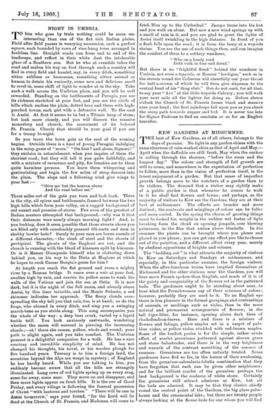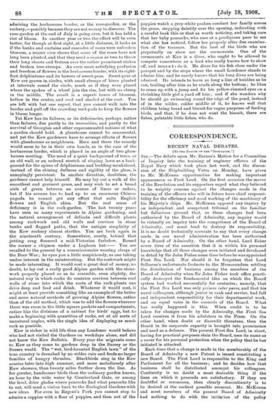KEW GARDENS AT MIDSUMMER,
THE best of Kew Gardens, as of all others, belongs to the days of promise. No light in any garden shines with the same clearness of rain-washed skies as that of April and May,— April when the daffodils are still fresh, May when the cuckoo is calling through the showers, "before the roses and the longest day." The colour and strength of full growth are still to come, and somewhere in the expectation of perfection to follow, more than in the vision of perfection itself, is the truest enjoyment of a garden. But that sense of imperfect growth belongs more to the watchers of a garden than to its visitors. The demand that a visitor may rightly make of a public garden is that whenever be comes to walk in it he shall find flowers and lawns ; and perhaps, as the majority of visitors to Kew see the Gardens, they are at their best at midsummer: The effects are broader and more distinct; the contrasts and minglings of colour can be fuller and more varied. In the spring the charm of growing things must be looked for, sought in the sudden wet lustre of light breaking from the cloud on opening jonquils, over blowing primroses, in the film that swims above bluebells. In the summer the plants can be brought where you please and placed as you please ; you can get any effect you like to choose out of the paintbox, and a different effect every year, merely by obedient oppositions of heights and colours.
The "bedding out" is what attracts the majority of visitors to Kew on Saturdays and Sundays at midsummer, and especially, in this particular summer, the foreign visitors. When the after-luncheon trains have emptied themselves at Richmond and the other stations near the Gardens, you will hear more French spoken than English, and much of it is of the gaiety and congeniality of the flowers set in the patterned beds. The gardeners ought to be standing about near, to bear what the Frenchwomen say of their schemes of colour; however, probably they are used to it. To an English eye there is less pleasure in the formal groupings and contrastings of annuals, or seedlings such as violas, than in the more natural and permanent arrangements of flowers ; in the tall tiger-lilies, for instance, opening above dark tiers of rhododendron-leaves. Here and there is a mixture of flowers and foliage, yellow maples set in a carpet of pale- blue violas, or yellow violas studded with red-brown maples. Some of the loudest praise is for the simple, rather crude effect of scarlet geraniums patterned against shaven grass and stone balustrades, and there is in the very brightness and warmth of the contrast something of the essence of summer. Geraniums are too often unfairly treated. Some gardeners have fled so far, in the horror of their awakening, from the geranium-calceolaria-lobelia combination that they have forgotten that each , can be given other neighbours ; and for the brilliant scarlet of the geranium perhaps the best background is the coolness of white stone. Certainly the geraniums still attract admirers at Kew, but all the beds are admired. It may be that they cluster chiefly round the central point of the Gardens, the big glass palm- house and the ornamental lake; but there are twenty people always looking at the flower-beds for one whom you will find
admiring the herbaceous border, or the rose-garden, or the rockery,—possibly because they are not so easy to discover. The rose-garden at the end of July is going over, but it has held a riot of bloom. In another year or two the effect will be even better, for though at first sight, at a little distance, it looks as if the banks and curtains and cascades of roses were unbroken blossom, a nearer view shows that some of the roses have not long been planted, and that they need a season or two to throw their long shoots and festoon over the rather prominent stakes and broken tree-stumps. An even more satisfying profusion and freedom of flowers is the herbaceous border, with its eight- foot delphiniums and its bowers of sweet-peas. Sweet-peas at Kew are grown in circles, with small clumps of blues planted at intervals round the circle, much as if they were placed where the spokes of a wheel join the rim, but with no clump in the middle. The result is a superb tower of blossom, hollow in the centre, and cool and shaded at the root. You are left with but one regret. that you cannot walk into the border and pull off the crowding seed-pods to keep the flowers in bloom longer.
Yet Kew has its failures, or its deficiencies, perhaps, rather than failures, due partly to its necessities, and partly to the survival of Georgian and other superannuated notions of what a garden should hold. A glasshouse cannot be ornamental, and yet the Kew gardeners have to arrange effects of flowers with glasshouses as neighbours. Here and there the remedy would seem to be in their own hands, as in the case of the herbaceous border, which is placed in an angle of two glass- houses meeting. The need of a quiet background of trees, or an old wall, or an ordered stretch of sloping lawn as a back- ground for the spires of delphinium and budding monkshood, instead of the shining dullness and rigidity of the glass, is annoyingly persistent. In another direction, doubtless, the gardener cannot help himself. He may lay out a walk of the smoothest and greenest grass, and may wish to set a broad aisle of green between an avenue of limes or cedars, but if his avenue has to lead up to an enormous Chinese pagoda he cannot get any effect that suits English flowers and English skies. But the real sense of deficiency is in the rock-garden. The last twenty years have seen so many experiments in Alpine gardening, and the natural arrangement of delicate and difficult plants among rockwork and old walls and crevices in stone banks and flagged paths, that the antique simplicity of the Kew rockery almost startles. You are back again in the nineteenth century. Somewhere, surely, behind that jutting crag flounced a mid-Victorian furbelow. Round the corner a chignon under a Leghorn hat— You are recalled to the present by a commissionaire wearing clasps of the Boer War ; he eyes you a little suspiciously, as one taking undue interest in the uninteresting. But the roeltwork might be made interesting. It would cost a great deal of money, no doubt, to lay out a really good Alpine garden with the stone- work properly placed so as to resemble, even slightly, the natural way in which rocks do contrive crevices between cool walls of stone into which the roots of the rock-plants can drive deep and feed and drink. Whatever it would cost, it might at least provide something like an example of the better and more natural methods of growing Alpine flowers, rather than of the old method, which was to add the flowers wherever there was room in the little square pockets and compartments, rather like the divisions of a cabinet for birds' eggs, but to make a beginning with quantities of rocks, set at all sorts of unnatural angles, with the single idea of displaying as much rock as possible.
Kew is richer in wild life than any Londoner would believe who had not visited the Gardens on weekdays alone, and did not know the Kew Bulletin. Every year the migrants come to Kew as they come to gardens deep in the Surrey or the Sussex weald. The "wet, bird-haunted English lawn" of the true country is drenched by no wilder rain and feeds no larger families of hungry thrushes. Blackbirds sing in the Kew acacias later into high summer, and more melodiously after Kew showers, than twenty miles further down the line. As for greater, handsomer birds than the ordinary garden knows, an hour by the wide water by Cumberland Gate, or among the level, drier glades where peacocks find what peacocks like to eat, will send a visitor back to the Zoological Gardens with new ideas. For even in Regent's Park you cannot stop to admire a coppice with a floor of poppies, and then out of the poppies watch a grey-white peahen conduct her family across the grass, stepping daintily over the opening, indicating with a careful beak this or that as worth noticing, and taking care that her baby peacocks, who race at a prodigious pace to see what she has noticed, follow her properly after due examina- tion of the treasure. But the best of the birds who are perpetually on show are the cormorants. One of the cormorants at Kew is a diver, who ought to be allowed to compete somewhere as a bird who really knows bow to show off, and means t3 do it. He dives for his fish close under the parapet and by the steps where the small Londoner stands to admire him, and he surely knows that his long dives are being admired. He intends to leave as long a line of bubbles as he can, trailing after him as he scuds along the bottom ; he likes to come up with a jump and fix his yellow-rimmed eyes on a shrinking little girl a yard off him ; and if she wonders why he should go swimming round the edge of the pond, instead of in the wilder, colder middle of it, he knows well that children bring bread and biscuit for vague purposes of feeding birds, and that, if he does not want the biscuit, there are fishes, palatable little fishes, who do.







































 Previous page
Previous page